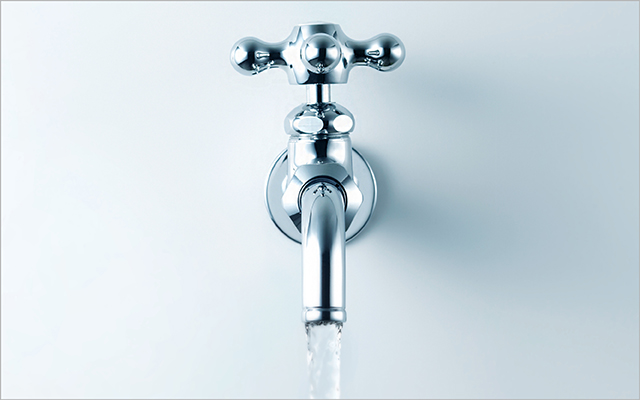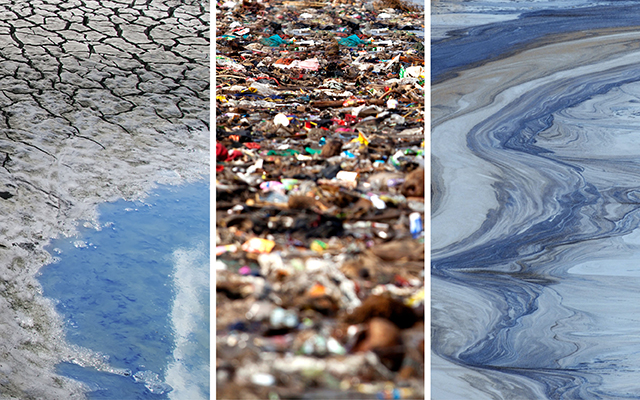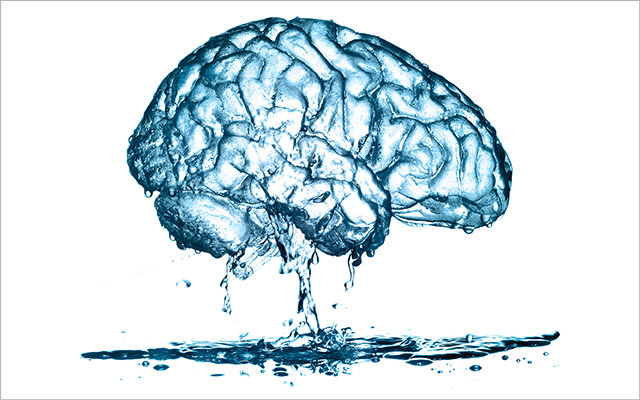If you’re enjoying a glass of water right now, consider that a dinosaur drank it before you did.
This is not a metaphor. Not one of the trillions of gallons of water on Earth is new — all of it has been here as long as the planet itself. Water circulates endlessly through the hydrologic cycle, evaporating from the ocean’s surface, condensing to form clouds, falling down as rain and snow, and rising up through springs and aquifers. Less than 3 percent of this water is fresh; the rest is salty.
And the water we have now is all we’re ever going to get.
The very thought of limits on fresh water can make a person thirsty, which makes sense. The human body is about 60 percent water, and we can’t survive longer than three days without drinking it. What’s more, we can’t just lean down and lap water from a puddle next to the curb, like dogs or birds — largely because we don’t have the bacteria in our guts that help us digest its particular microorganisms.
We need water without microbes, which could make us sick immediately, and without chemical contaminants — like perchlorate, chromium-6, and methane, which have all been found in groundwater sources and may make us sick eventually.
Notably, the majority of us in the United States have drinkable water with the simple turn of a faucet — yet we often choose to avoid it.
Anxious about increasing groundwater pollution, as well as recent infrastructure disasters like the one in Flint, Mich., and elsewhere, many of us habitually turn away from the tap and toward bottled water, which is marketed as a healthier alternative.
But unless we’re in an emergency situation (or no other water is available), the assumption that bottled water is safer or better than the tap is usually wrong.
“The fact is, despite Flint — and Flint is a tragedy for a lot of reasons — more people get safe tap water today than ever before in human history,” says James Salzman, JD, MSc, a professor of environmental law at UC Santa Barbara and UCLA. “People take that for granted.”
“The fact is, despite Flint — and Flint is a tragedy for a lot of reasons — more people get safe tap water today than ever before in human history,” says James Salzman, JD, MSc, a professor of environmental law at UC Santa Barbara and UCLA. “People take that for granted.”
Salzman and other public-health experts suggest that the belief that bottled water will protect us from the risks of groundwater pollution and an aging water infrastructure is misguided. This conviction also comes with a high price tag, both economically and environmentally.
In the pages that follow, these experts and others explain how to choose — and treat — our drinking water more wisely.
Back to the Source
Our contemporary affection for bottled water has deep historical roots. In his book Drinking Water: A History, Salzman writes that “from earliest times, natural water sources have been linked with mystical healing and divine powers.”
During the Middle Ages, Salzman explains, Scots visited a well called St. Maelrubha’s to be cured of insanity, while those seeking relief from toothaches visited another well on the isle of North Uist. This was more than just quaint superstition: These wells probably had water high in minerals now known to have medicinal effects. St. Maelrubha’s, for example, may have contained lithium, a mineral that is used to treat bipolar disorder. Importantly, for those in search of healing, these impurities made the magic.
“There is no such thing as pure water in nature,” Salzman states.
All spring water starts as rain or snow, which seeps into the ground and ascends again through a spring. If it passes through limestone on its journey, it will be high in calcium and magnesium. For good and for ill, water takes on the character of its surroundings, just like the rest of us do.
This is a key reason why bottled water first gained popularity as a commodity. In 19th-century Europe, spa waters were legendarily healing — for bathing and drinking — because they tasted like the particular minerals at their origins. When savvy spa owners realized they could bottle the spa experience and people would pay to take it home, the market for medicinal water was born. Every wealthy European had a favorite bottled water. It tasted good, it enhanced your health, and it made you look worldly.
This is how Americans viewed bottled water in the 1970s, when Perrier mineral water arrived in the United States and became a mark of health and status on restaurant tables. Still, it was generally viewed as an expensive indulgence, like wine.
That soon changed. By 1999, each American drank 17 gallons of bottled water each year. Today we each consume about 40 gallons — and most comes from single-serve plastic bottles.
“Across America,” notes Salzman, “people are opening about 1,500 bottles of water every second.”
3 Reasons to Ditch Bottled Water
These days, we typically choose bottled water for reasons of convenience and health. Its contents are undoubtedly more wholesome than the neon beverages surrounding it in most vending machines, but the labels — many featuring mystical mountain streams — are deceptive. The real magic in most bottled water actually comes from marketing.
Here are a few major drawbacks hidden behind that label:
1. Expense
Bottled water “can cost thousands of times as much as tap water,” explains Mary Grant, a policy analyst with the consumer watchdog group Food & Water Watch. And yet most bottled water is municipal tap water.
Only about 55 percent of brands source their water from underground aquifers. If they do, their products can be legally labeled “spring water.” But Salzman points out that the top three brands — Aquafina, Dasani, and Pure Life — are all “highly filtered tap water.”
“Unless there’s some credible reason to suspect your tap water is unsafe,” he says, “I think you’re wasting your money if you’re buying bottled water for health reasons.”
Manufacturers don’t mind. Salzman explains in his book that the actual water in the bottle costs between 240 and 10,000 times less than the retail price. So that $1.50 you pay for a single bottle would buy 1,000 gallons of tap water in most cities. He likens it to a “$10,000 sandwich.”
2. Waste
Bottled water is a resource-heavy industry. “Every step of the process of getting bottled water to you creates waste and uses energy,” says Grant. “From the production of plastic bottles and the transportation of those bottles to their disposal at the end — it’s a very energy-intensive process.”
To wit: Americans throw away about 60 million water bottles a day — that’s around 22 billion a year. Less than a quarter of these are recycled, and when they are, recycling itself requires large amounts of water.
It takes 3 liters or more of water to produce 1 liter of bottled water, and the vast majority of this water is contained in petroleum-based plastic.
It takes 3 liters or more of water to produce 1 liter of bottled water, and the vast majority of this water is contained in petroleum-based plastic.
The Pacific Institute estimates that about 17 million barrels of oil are used to make plastic water bottles each year — and the total energy involved in the bottled-water industry is equivalent to filling each bottle about a quarter full with oil.
Finally, there’s shipping. The Natural Resources Defense Council found that bottled-water imports to California alone amount to about 9,700 tons of carbon dioxide per year, as much as the pollution emitted annually from 1,700 cars.
3. Safety
Thanks to marketing campaigns that emphasize “nature with a capital N,” bottled water seems safer than tap, says Salzman, but “there’s no reason to think that. Sometimes bottled water is cleaner than tap, sometimes it’s not. There are also contaminants that get into bottled water.”
A 2008 Environmental Working Group study found 38 contaminants, including agricultural residue and traces of toxins that exceeded the legal limits for bottled water in California, across 10 popular brands.
When tap water is certifiably compromised, as it was during the recent pipe-corrosion catastrophe in Flint, or if you live near known polluters and have frequent boil orders and alerts, bottled water is undoubtedly the safer option. But in general, Salzman says, bottled and tap water are equal with regard to safety — except that “bottled water is less stringently regulated.”
Grant concurs. Tap and bottled water are monitored by different federal agencies, and the oversight of bottled water is markedly weaker.
“The Environmental Protection Agency regulates tap water under the Safe Drinking Water Act,” she says. The act, passed in 1974 to protect the public water supply, requires the EPA to monitor more than 90 contaminants in municipal tap water, including microorganisms, naturally occurring contaminants like arsenic, and some chemicals.
Unless they’re remiss in their regulatory obligations, as in Flint, most municipalities test their water daily (some much more often than that) and then correct for contaminants as needed. New York City, for example, tests its water 330,000 times per year. The EPA requires local regulators to notify the public immediately if any contaminant posing a threat to human health exceeds its maximum levels, which is how the decision to issue boil orders and other warnings is made.
By contrast, bottled water is regulated by the Food and Drug Administration, and tested weekly. Manufacturers must remove excess contaminants, but they’re not required to tell the public if and when they’re found. (Unless a news organization reports a problem or a watchdog group performs an independent analysis, there’s no way for consumers to know if there has been contamination in a brand’s supply.) So while the label on a bottle of water reveals nothing about its contents — which Salzman describes as a “sin of omission” — tap-water contaminants are clearly identified in mandated documents.
“Every water system is required to put out a water-quality report every year,” Grant explains. “This report will tell you all the contaminants that they found in the water system and all the water-quality violations they had.”
Although “the vast majority of water systems have no water-quality violations,” she adds, the threat of water contamination from industry persists. This is where the real problem with water safety lies. (See “Troubled Waters.”)
Going Deeper
Those of us concerned about water safety have to go back to the source. This means working to ensure that our groundwater is protected from threats posed by industrial and agricultural pollution, being mindful of our own water consumption and water infrastructure, and voting for political candidates who support regulations that protect our water. Asking water suppliers to do all the work isn’t fair, says Salzman.
“We need to be vigilant about our source waters,” he insists. “With heavy agricultural states, we’ve got overapplication of fertilizer and pesticides, and the water suppliers are basically told to clean all that up. It would be a lot easier, less expensive, and probably safer if we reduce the effects upstream,” he says.
“It’s the old adage: An ounce of prevention is worth a pound of cure.”
Grant is concerned that the false promise of bottled water distracts us from other important factors at play in drinking-water safety.
“Reliance on bottled water contributes to the distrust of tap water,” she says. “That can hurt public willingness to invest in our water systems to ensure that everyone has access to safe water.”
Those water systems include our aging infrastructure. Salzman notes that many of the pipes in older cities were laid soon after the Civil War. These systems badly need attention — especially those with lead pipes and service lines vulnerable to leaching.
When it comes to these underground systems, he says, “we are facing a similar infrastructure challenge as we are with bridges and roads. In this case, though, the structures are invisible.”
Overall, Salzman recommends that we learn to shift our thinking from that of water consumers to water citizens. This means taking responsibility for the condition of our drinking-water sources and infrastructure. It may even mean being willing to pay higher water rates in exchange for infrastructure investments and more-effective laws.
“We take cheap, safe drinking water for granted, and it is an enormous achievement of our society that we can do that. But the fact is that providing reliably safe drinking water can be expensive and requires resources,” he says.
Grant agrees that our water system requires more investment, but she notes that federal dollars allocated to water infrastructure and protection have been cut by 74 percent since 1977. In her view, people with low or fixed incomes cannot afford rising rates, so Food & Water Watch argues for more federal investment.
Regardless of who ultimately foots the bill for greater investments in water protection and infrastructure, Salzman and Grant agree that concerned citizens who recognize the value of this precious limited resource are essential.
Salzman emphasizes that civic engagement may be one of the most powerful forces to protect areas from environmental harm. He cites a study by researcher James Hamilton that found the “single most powerful predictor for undesirable land use, like placing hazardous waste sites in communities, was voting percentage.”
The solution to drinking-water issues may not come in a bottle, but we shouldn’t underestimate our power as citizens to protect it. The dinosaurs were kind enough to leave us this supply. Let’s do the same for coming generations.
How to Choose a Water Filter
Different household filters address different contaminants, and they vary widely in price and convenience. This step-by-step guide will help you find a filter that’s best for you.
1. Get your water-quality report. Your municipal water company is required to publish an annual water report with up-to-date measurements of more than 90 possible contaminants. It will show if any of the contaminants exceeded the maximum contaminant level allowed by the EPA. Get your water-quality report by calling your municipal supplier or, in many cases, typing your city and state into the EPA website: www.epa.gov/ccr.
2. Test your home for lead. Even if your water report doesn’t show high lead levels in your municipal water supply, lead pipes in your home (common in houses built before 1986) can also put you at risk for exposure.
To test your water for lead, ask your municipal supplier to send someone out; some suppliers will test your water for free. If that’s not the case in your area, you can buy a lead-testing kit from a hardware or home-improvement store. If you discover there is lead in your tap water, get an NSF/ANSI–certified filter to remove it (see step 3).
Other strategies for reducing lead when you’re away from home and can’t test the water: Run water until it’s ice cold before using. This flushes water that has been sitting in the pipes, which contains the greatest amount of lead. Never consume hot water from lead pipes.
3. Pick your target and purchase your filter. Water-filtration systems vary widely in price and purpose, but be sure that the filter you choose is NSF/ANSI approved, says Mary Grant of Food & Water Watch. NSF International develops public-health standards globally. Use its filter guide to locate the type of filter (filtration, distillation, reverse osmosis, etc.) required for specific contaminants: bit.ly/1Gq54BB.|
Go-To Filters
Carafe or Pour-Through Filters: Carafes and pitchers fitted with carbon filters are the most convenient and inexpensive options for filtering water. They reduce most common contaminants and improve the taste and smell of tap water, but many of them don’t remove lead or chloramine, a byproduct of water disinfection.
Faucet-Mounted Filters: Like carafe filters, faucet-mounted filters are simple to install and usually inexpensive, though they can slow the flow of water. They’ll improve tap-water taste and smell and remove most common contaminants.
Countertop Filters: These can be easier to use over time than faucet-mounted or carafe filters, since they don’t clog as easily. They are similarly effective.
Plumbed-In Filters: These filters are placed directly in your pipes and can dispense filtered water through a separate tap.
Whole-House Filtration: Installed in the water main, these are generally the longest-lasting systems. They filter all the water in the house, but may not remove as many common contaminants as other types of filters.|
How to Be a Good a Good Water Citizen
Simple tips to help you break the bottled-water habit and protect our groundwater.
• Invest in a portable glass or stainless-steel water bottle that you’ll enjoy using throughout the day, and take advantage of the increasing number of water filtration stations in airports, health clubs, gyms, and sports stadiums.
• Buy a home water-filtration system. This commitment can be as modest as a $20 carbon filter (see “How to Choose a Water Filter” above). Encourage your employer to install a water filter.
• Educate yourself about water issues in your area, and alert your local and national lawmakers about them.
• Support increased EPA regulation of water sources, especially ones that eliminate loophole chemicals like those related to farming and fracking, to keep our water clean.
This article originally appeared as “Truth on Tap.”




This Post Has 0 Comments